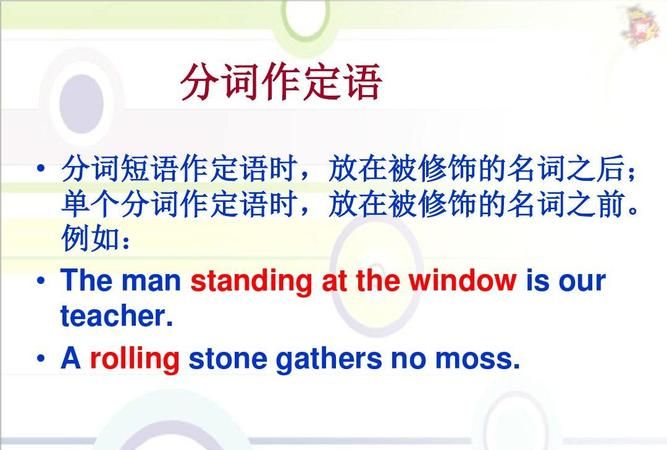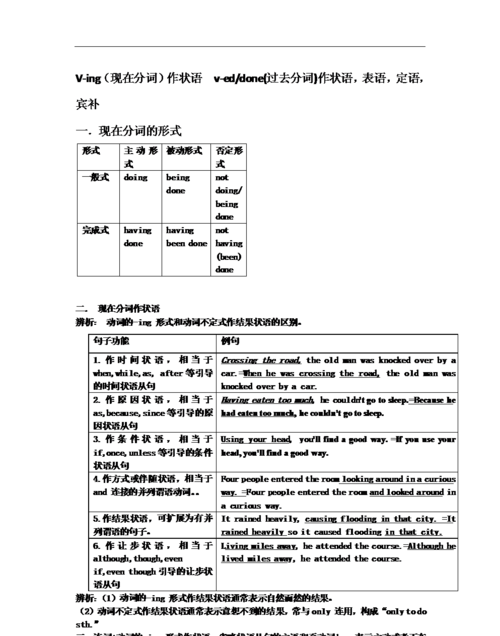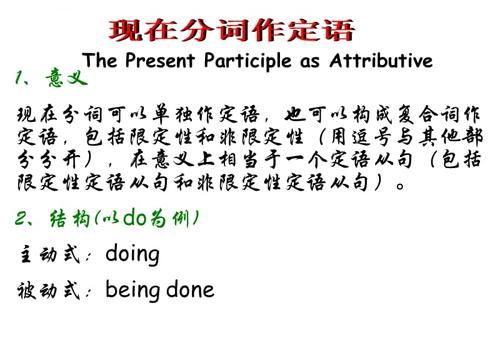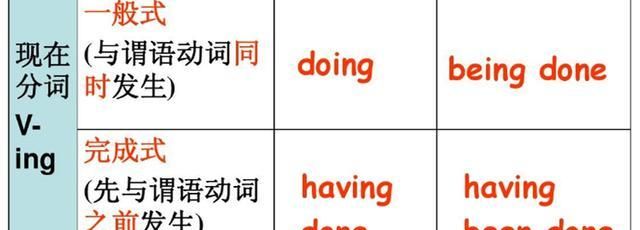本文目录
现在分词与动名词做定语的用法
现在分词作定语 状语的用法
现在分词在句中起形容词和副词的作用。现在分词用定语时相当于一个定语从句;作状语表示时间、原因、条件等时相当于一个状语从句。然而,我们在使用现在分词时应注意两方面的问题。
��一、作定语
��现在分词短语作定语通常置于所修饰的名词或代词之后,现在分词短语作后置定语时,应注意下列三点:
��1.现在分词表示的动作和谓语动词表示的动作是一先一后发生而不是同时发生时,不能用现在分词作定语,应使用定语从句表示。如:
��(误) The teacher criticized the student having broken the window.
��(正) The teacher criticized the student who had broken the window.
��(误) Do you know anyone having lost a car ?
��(正) Do you know anyone who have lost a car ?
��2.being可用状语或补语,但不可作定语。如:
��(误) Anybody being outside after ten o’clock will be criticized.
��(正) Anybody who is outside after ten o’clock will be criticized.
��3.表示经常性或已完成的非进行动作的时候,不用现在分词作定语。例如:
��(误) The boy bringing us milk everyday is my brother.
��(正) The boy who brings us milk everyday is my brother.
��二、作状语
��现在分词作状语,我们必须注意以下四点:
��1.现在分词作状语与谓语动词的时间关系。
��现在分词所表示的动作与谓语动词表示的动作同时发生时,现在分词用一般式。如:
��The secretary worked late into the night, preparing a long speech for the president.
��He sent me an E-mail, hoping to get further information.
��现在分词所表示的动作先于谓语动词的动作时,现在分词要用完成式。如:
��Having suffered from heart trouble for years, Professor White has to take some medicine with him whenever he goes.
��Having finished his homework, the boy went out to play football.
��2.现在分词作状语与主语的关系。现在分词作状语时,其逻辑主语与句子主语必须保持一致。如果不一致,分词应有自己的逻辑主语,构成独立主格结构。如:
��Looking out of the window of our hotel room, we could see lots of mountains around.
��They came into the classroom, talking and laughing.
��Mr. Smith being absent, the meeting had to be put off.
��It being a fine day, we all wanted to go outing.
��3.现在分词作状语时,前面可用连词when, while, once 等。如:
��When talking to you, I always feel happy.
��Be careful while crossing the street.
��4.现在分词作状语时与主语之间不能有并列连词or, and, but等,因为并列连词连接的是两个并列的成分,而分词短语只是全句的一个状语部分,但分词与主语之间可用逗号。如:
��(误) Having been told many times, but he still couldn’t understand it.
��(正) Having been told many times, he still couldn’t understand it.

现在分词作状语
回答:
现在分词作状语时,可以表示时间、条件、原因、伴随、方式等,其逻辑主语要和句子主语要一致。现在分词作状语时,有主动语态和被动语态,有一般式(doing, being done)和完成式(having done, having been done)。其一般式表示现在分词的动作与句子谓语的动作同时发生或现在分词动作一发生,谓语动作紧跟着发生;其完成式则表示句子谓语的动作在现在分词的动作之后发生。现在分词的否定是在其前面加not。例如:
Being ill(=As he was ill), he didn't come.
Hearing the news(= When he heard the news), he jumped with joy.
Having finished the work(= After he had finished the work), he went home.
Not working hard (= If you don't work hard), you will be fired(解雇).
Being repaired now(= As the library is being repaired now), the library cannot be open to the public.
He stood there stairing at Mary(= and staired at Mary).
现在分词作定语有前置和后置之分。单个词一般要前置;两个词以上的短语必须后置。 现在分词作定语可以表示:1)正在进行的动作;2)主动关系,但不在进行。现在分词作定语时有一般式,但没有完成式;有主动语态(doing)和被动语态(being done)。例如:
I know the man standing there(= ... the man who is standing there).
They cried at the exciting news (= ... at the news which is exciting).
The house facing south(= The house which faces south) is a clinic.
The car being repaired now(= The car which is being repaired now) is Jane's.
过去分词作定语也有前置和后置之分,单个词一般要前置,偶尔也有后置的;两个词以上的短语必须后置。过去分词作定语时表示:1)被动关系,无时间性; 2 ) 被动关系,完成的动作。 但是,不及物动词的过去分词作定语则表示主动关系,完成的动作。例如:
She is cleaning the fallen leaves(=... the leaves which have fallen) in front of the house.
This is a photo taken last week(= ... a photo which was taken last week).
There are five minutes left ( ...five minutes which have been left).
I like read the works written by Lu Xun( = the works which were written by Lu Xun).
Polluted air and water ( = Air and water which are polluted) will affectour health.
He is a retired worker (= ...a worker who has retired).
We know the student called Jack (= ... the student who is called Jack).

现在分词作定语和定语从句的区别
现在分词作定语从句
I.ing 形式作定语
1. 现在分词作前置定语时,在逻辑上与所修饰的名词之间为主谓关系,也可改成定语从句;如果与所修饰的名词之间没有主谓关系,定语相当于一个介词for引导的短语。现在分词位于所修饰的名词之后做后置定语,与所修饰的名词之间呈逻辑上的主谓关系,相当于一个定语从句。如:a listening child= a child who is listening, a walking stick= a stick for walking.
2. 现在分词作定语往往表示“令人”,主动的或正在进行的动作。如:a moving film, a developing country.
II. ing 形式作状语
动词-ing形式在句子中做状语,表示的动作是主语动作的一部分,与谓语动词表示的动作或状态是同时或者几乎同时发生的,经常可以做时间、原因、方式、条件、结果、目的、让步状语从句。句子的主语必须是状语的逻辑主语;而且主语与作状语的分词之间呈逻辑上的主谓关系。
1.原因状语,相当于原因状语从句。
1).Being ill, she didn’t go to school today.
因为生病,她今天没上学去。
2). Seeing no one at home, I decided to come again.
看见没有人在家,我决定再来一趟。
2. 时间状语,相当于when, while等引导的从句。
1).Hearing the good news, he jumped with joy.
当听到这个好消息时,他高兴地跳了起来。
2).Walking in the street, I saw a friend of mine.
当我走在街上时,我看到了我的朋友。
如果分词短语表示的动作与谓语表示的动作同时发生,常在分词短语前加上when或while。
3).Be careful when crossing the street.
过街时小心。
3. 伴随状语,与谓语所表示的动作同时发生。
1).He sat at the table reading China Daily.
他坐在桌子旁看《中国日报》。
2).Talking and smiling, they went into the room.
他们又说又笑地走进房间。
4. 结果状语。
1).The mother died, leaving a lot of money for her children.
母亲去世了,给她的孩子留下了一大笔钱。
5. 条件状语。
Turning right, you will find the place you want.
往右转弯,你就会找到你要找的地方了。
III.现在分词短语作状语时,它的逻辑主语一般须与句子的主语一致。作状语的分词相当于一个状语从句。
1).Seeing from the top of the hill, we can see our beautiful school.
从山顶望下去,我们就能看到我们美丽的.学校。
但有时它也可以有自己独立的逻辑主语,独立主语=逻辑主语+现在分词表示伴随,时间、原因,条件。
2).Many people being absent, they decided to put the meeting off.
由于许多人都缺席了,他们决定取消这次会议。
IV. 现在分词的否定形式。
现在分词的否定式:not+ v.ing
完成式的否定式:not+ having done
Not having heard from her son for a long time, the mother worried a great deal.
由于很久没有收到儿子的来信,这位母亲很担心。
V. 现在分词的时态和语态的用法。
1). 分词一般式表示的动作和谓语动词所表示的动作一般同时进行时,则用分词的一般式形式。
He walked on the street, seeing back from time to time.
他走在街上,不时地向身后看看
2). 如果分词所表示的动作先于谓语动词发生,则用分词的完成式形式。
Having finished his work, Henry went home.
完成了他的工作后,亨利回家了。
语法聚焦预习自测
1._________ her telephone number, I couldn’t ring her up.由于不知道她的电话号码,我无法打电话给她。
2. ____________________, we will go there on foot.
天气好的话,我们将步行去那里。
3.___________________, I met Mary.
上学时我遇见了玛丽。
4. I turn off the light, ____________________.
我把灯关了,所以什么也看不见。
5. _____________________, you will succeed. 努力工作,你就会成功。
6. _____________________ his le第一文库网tter, I decided to write to him. 没收到他的来信,我决定给他写信。
7. The building __________(build) now is our new library.
8. __________________________(give) such a good chance, how could you let it slip away?
9. He stood, __________(lean) against the wall/
10. The song is sung all over the country, _______ (make) it the most popular song.
答案:
1. Not knowing 2. Weather permitting
3. While going to the school 4. seeing nothing
5. Working hard 6. Not receiving 7. being built
8. Having been given 9. leaning 10. making
课内探究案
探究总结动词-ing的用法
教学建议:如何判断非谓语动词的形式和动词-ing的各种形式是重点,帮助学生形成判断的依据和规则,注意v-ing作状语时的特性:时间性、语态性和主语一致性。
1. 动词的-ing形式做状语时表示什么含义?
______________________________________________
______________________________________________
答案:动词-ing形式在句子中做状语,表示的动作是主语动作的一部分,与谓语动词表示的动作或状态是同时或者几乎同时发生的,经常可以做时间、原因、方式、条件、结果、目的、让步状语从句。句子的主语必须是状语的逻辑主语;而且主语与作状语的分词之间呈逻辑上的主谓关系。
2.动词的-ing形式变化:
主动形式
被动形式
一般式
完成式
答案:
主动形式
被动形式
一般式
doing
being done
完成式
having done
having been done
3. 现在分词的否定形式是什么?
____________________________________________________________________________________________
答案:
现在分词的否定形式:
现在分词的否定式:not+ v.ing
完成式的否定式:not+ having done
II. 学以致用
一、词汇运用
1. It rained heavily in the south, serious flooding in several provinces.(2010 天津)
A. caused B. having caused C. causing D. to cause
2. at my classmates' faces, I read the same excitement in their eyes.(2010 北京)
A. Looking B. Look C. To look D. Looked
3. The retired man donated most of his savings to the school damaged by the earthquake in Yushu ,________the students to return to their classrooms.(2010 江苏)
A. enabling B. having enabled
C. to enable D. to have enabled
4 The lady walked around the shops, _______ an eye out for bargains.(2010 江西)
A keep B kept C keeping D to keep
5. Lots of rescue workers were working around the clock, supplies to Yushu, Qinghai province after the earthquake.(2010 福建)
A. sending B. to send
C. having sent D. to have sent
6. He had a wonderful childhood, _______with his mother to all corners of the world.(2010 安徽)
A. travel B.to travel. C. traveled D. traveling
7. Dina, for months to find a job as a waitress, finally took a position at a local advertising agency.(2010 湖南)
A. struggling B. struggled
C. having struggled D. to struggle
8. The lawyer listened with full attention, to miss any point.(2010 四川)
A.not trying B.trying not
C.to try not D.not to try
9. The news shocked the public, _______to great concern about students’ safety at school.(2010 重庆)
A. having led B. ledC. leading D. to lead
答案:
1. CAACA 6. DCBC
Ⅲ.学贵有疑——我思考,我收获!
学习建议:结合以上学习,请你用3-5分钟的时间与同学自由质疑和答惑。
Ⅳ.我的收获——反思静悟、体验成功
——请写出本堂课学习中,你认为感悟最深的一至两条收获。

现在分词与动名词做定语的用法
注意:现在分词作定语时表示动作正在进行或与谓语动词所表示的动作几乎同时发生。如果两个动作有先有后,一般不能用现在分词作定语,而要用定语从句。如:
The teacher criticized the student who had broken the window.
①现在分词作定语
A.现在分词作定前置时静感强,而后置的现在分词动感强。如:
The working people are the wisest.
The farmers working here are very busy.
能前置的现在分词为数不太多,常见的大都是已被形容词化了的现在分词,前常有程度副词,有些现在分词甚至还有比较等级。如:
I have brought very exciting news to you.
This is the most exciting story that I have ever read.
B.有些现在分词作定语时表示正在发生的动作,这些现在分词若改为定语从句宜用进行时态。如:
Did you tell the children playing there not to make any noise ?
Did you tell the children who were playing there not to make any noise ?
The American president visiting China now will return on Saturday.
The American president who is visiting China now will return on Saturday.
有些现在分词作定语时表示经常性动作或现在(或当时)的状态。此类现在人词若改为定语从句宜用一般时态,而不宜用进行时态。如:They stayed at a hotel standing (which stood) by the lake.
The temple standing (that stood) on top of the hill was built in the Ming Dynasty.
打字不易,如满意,望采纳。

以上就是关于现在分词作定语表示什么 ,现在分词与动名词做定语的用法的全部内容,以及现在分词作定语表示什么 的相关内容,希望能够帮到您。
